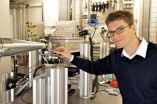(Press-News.org) A study led by researchers at UC Davis has found how the bacteria Salmonella enterica — a common cause of food poisoning — exploits immune response in the human gut to enhance its own reproductive and transmission success. The strategy gives Salmonella a growth advantage over the beneficial bacteria that normally are present in the intestinal tract and promotes the severe diarrhea that spreads the bacteria to other people.
The findings are published in the Sept. 23 issue of the journal Nature.
"The human body normally has 10 times more microbes than human cells that help protect us against infection from disease-causing bacteria," said Andreas Bäumler, professor of medical microbiology and immunology at the UC Davis School of Medicine and the principal investigator of the study. "We have discovered Salmonella's cunning trick that allows it to quickly take over and outgrow the beneficial microbes in our intestine."
All bacteria must generate energy in order to live and reproduce, either by respiration — which usually requires oxygen — or fermentation. Because essentially no oxygen is available in our intestines, the beneficial bacteria that reside there tend to use fermentation, which is less efficient than respiration for obtaining energy.
When people ingest Salmonella, it invades the surface of the intestine. Our immune system responds by producing oxygen radicals to kill the bacteria. Although some Salmonella bacteria are killed by this response, many more benefit: the oxygen radicals create a sulfur compound called tetrathionate, which Salmonella are able to use instead of oxygen for respiration.
Interestingly, tetrathionate has been used since 1923 by microbiologists as a way to promote the growth of Salmonella in biological samples containing competing microbes. But because tetrathionate was not known to exist in living people, it was assumed prior to this study that this process had little relevance for food poisoning. Up until now, tetrathionate was believed to mainly exist naturally in decaying corpses or in thermal springs.
"Stimulating the host to produce tetrathionate enables Salmonella to 'breathe' in the intestine," said Sebastian E. Winter, who is a member of Bäumler's laboratory and lead author of the article. "This gives Salmonella a tremendous advantage over the gut bacteria that must grow by fermentation."
By stimulating an inflammatory response in the intestine, Salmonella also enhances its transmission to other hosts. The inflammatory response causes the severe diarrhea and vomiting that is the body's attempt to rid itself of the pathogenic bacteria, at the same time enabling Salmonella's spread.
The investigators used a combination of experiments with mouse models and test tubes to study the effects of intestinal inflammation on Salmonella and pinpoint the role of tetrathionate respiration. They also used novel techniques from the burgeoning field of metabolomics, which allowed them to measure metabolites in living animals.
Salmonella is frequently in the news as a source of food poisoning outbreaks, usually from eating poorly cooked or unhygienically prepared eggs or meat. Salmonella was the cause of a recall of about half a billion eggs last August and sickened more than 1,500 people. In that case, the ovaries of the hens were contaminated, so the inside of the eggs carried the bacteria and were not safe to eat unless thoroughly cooked. Reptiles such as turtles, lizards and snakes also carry the bacteria on their skin, sometimes causing illness in people who keep them as pets.
Salmonella infection, known as salmonellosis, causes diarrhea, fever, vomiting and abdominal cramps. Although most people recover after several days, it may be fatal, especially in the elderly, infants, and people with an impaired immune system.
For most cases of salmonellosis, antibiotic treatment is counterproductive, as it actually prolongs disease by further inhibiting the growth of beneficial bacteria. Finding that tetrathionate is important in human Salmonella infection opens up new avenues for research in finding an effective treatment for salmonellosis.
"Determining how Salmonella is so efficient in outcompeting resident beneficial bacteria is a critical first step in developing new drugs for treating food poisoning," said Bäumler, whose group is now pursuing this avenue of research. "We are hopeful that by targeting sulfur compounds we can stop the bacteria from establishing a foothold in the intestine."
INFORMATION: Other UC Davis authors of the article are Parameth Thiennimitr, Maria G. Winter, Brian P. Butler, Douglas L. Huseby, Robert W. Crawford, Joseph M. Russell, Charles L. Bevins, Renée M. Tsolis, and John R. Roth. The other study author is L. Garry Adams from the College of Veterinary Medicine at Texas A&M University.
The UC Davis School of Medicine is among the nation's leading medical schools, recognized for its research and primary-care programs. The school offers fully accredited master's degree programs in public health and in informatics, and its combined M.D.-Ph.D. program is training the next generation of physician-scientists to conduct high-impact research and translate discoveries into better clinical care. Along with being a recognized leader in medical research, the school is committed to serving underserved communities and advancing rural health. For more information, visit UC Davis School of Medicine at www.ucdmc.ucdavis.edu/medschool/.
END
LA JOLLA, CA – September 20, 2010 –– A team at The Scripps Research Institute has detailed the structure of a member of the only remaining class of multidrug resistance transporters left to be described. The work has implications for combating dangerous antibiotic resistant strains of bacteria, as well as for developing hardy strains of agricultural crops.
The study was published in an advance, online issue of the journal Nature on September 22, 2010.
"Now with our crystal structure, scientists can for the first time figure out exactly how this transporter works," ...
Osteoporosis, a medical condition in which bones become brittle and fragile from a loss of density, is among the most common diseases in aging bones: In Germany around a quarter of the population aged over 50 is affected. Patients' bone material shrinks rapidly, leading to a significantly increased risk of fracture. In clinical research to date, osteoporosis is diagnosed almost exclusively by establishing an overall reduction in bone density. This approach, however, gives little information about the associated, and equally important, local structure and bone density changes. ...
Women who survive breast cancer often suffer from functional limitations that affect motion, strength and dexterity, which may adversely affect all-cause and competing-cause survival but not breast cancer survival, according to a study published online September 22 in The Journal of the National Cancer Institute.
Breast cancer survivors who have functional limitations that affect motion, strength, and dexterity are at the same risk of dying from a recurrence of breast cancer as physically fit survivors, but are more likely to die from other causes.
Breast cancer survivorship ...
SAN FRANCISCO, CA—September 23, 2010—Scientists at the Gladstone Institute of Neurological Disease (GIND) have uncovered new approaches to reduce toxic proteins in Alzheimer's disease (AD) and other neurodegenerative diseases. The results might lead to new treatments for these diseases.
"We examined a protein called tau that has been strongly implicated in Alzheimer's disease," said Li Gan, PhD, senior author on the study. "Tau forms toxic protein aggregations in the brains of Alzheimer patients."
Tau is a common protein in the central nervous system where it helps ...
FORT COLLINS – The hiatus of global warming in the Northern Hemisphere during the mid-20th century may have been due to an abrupt cooling event centered over the North Atlantic around 1970, rather than the cooling effects of tropospheric pollution, according to a new paper appearing today in Nature.
David W. J. Thompson, an atmospheric science professor at Colorado State University, is the lead author on the paper. Other authors are John M. Wallace at the University of Washington, and John J. Kennedy at the Met Office and Phil D. Jones of the University of East Anglia, ...
PORTLAND, Ore. — Researchers at Oregon Health & Science University have discovered that a form of cell division typically associated with cancer called multipolar mitosis can yield diverse, viable cells capable of protecting the liver from injury and poisonous substances, such as pesticides, carcinogens or drugs. Their findings are published online in the journal Nature.
"Our findings show that the liver, which is known to have a tremendous capacity for regeneration, also has an amazing degree of diversity. A better understanding of this process may reveal why some individuals ...
Spanish researchers have confirmed there is a genetic risk factor for osteoporosis and bone fractures. Although more studies are still needed, these findings will make it possible to take preventive measures.
Scientists from the University of Barcelona (UB) have discovered that the genetic variant 677C>T (a single nucleotide polymorphism (SNP) that is very well known in genetic studies) is linked to osteoporotic vertebral fractures, which many women suffer from after the menopause.
"In this genetic variant, the women that displayed a TT combination (or genotype) had ...
Women who smoke during pregnancy run the risk of adversely affecting their children's coordination and physical control according to a new study from Örebro University, Sweden, published in the Journal of Epidemiology and Community Health.
– Moreover, we discovered that boys' abilities may be affected to a greater extent than those of girls, says Professor Scott Montgomery at Örebro University.
– There is a link between nicotine and testosterone. Nicotine can influence development of the brain and interacts with testosterone particularly during the foetal stage, and ...
Why do airline tickets become more expensive as the travel date approaches whereas theater tickets are sold at half price in Leicester Square on the day of the performance? In their recent article published in the Economic Journal, ("Advance Purchase Discounts versus Clearance Sales"), Professors Marc Möller and Makoto Watanabe from the UC3M Department of Economics have considered the pricing of products that can be purchased in advance, i.e., long before their actual date of consumption. Further examples include seasonal products like the newest skiing equipment or entry ...
NGC 1365 is one of the best known and most studied barred spiral galaxies and is sometimes nicknamed the Great Barred Spiral Galaxy because of its strikingly perfect form, with the straight bar and two very prominent outer spiral arms. Closer to the centre there is also a second spiral structure and the whole galaxy is laced with delicate dust lanes.
This galaxy is an excellent laboratory for astronomers to study how spiral galaxies form and evolve. The new infrared images from HAWK-I are less affected by the dust that obscures parts of the galaxy than images in visible ...





